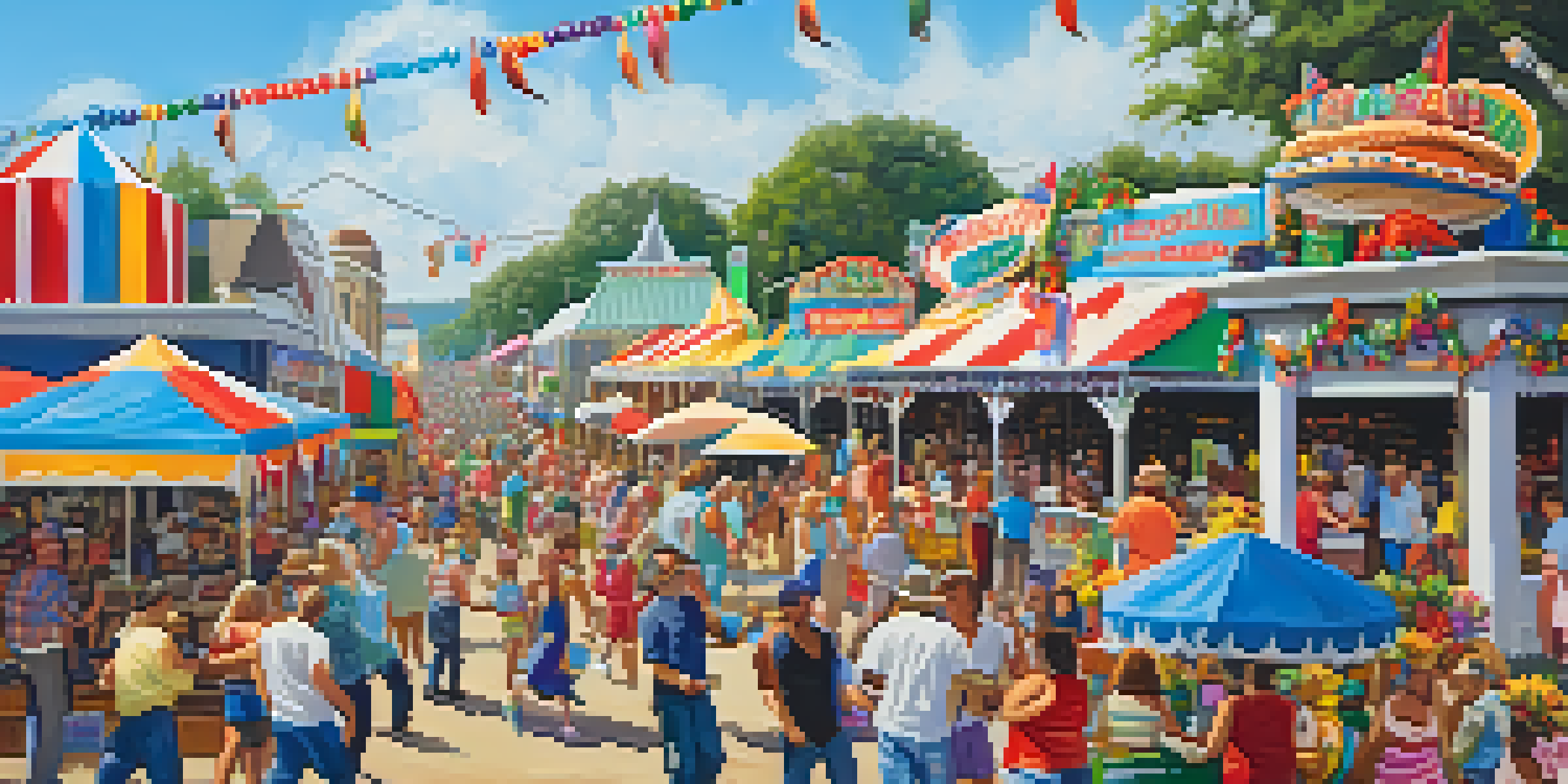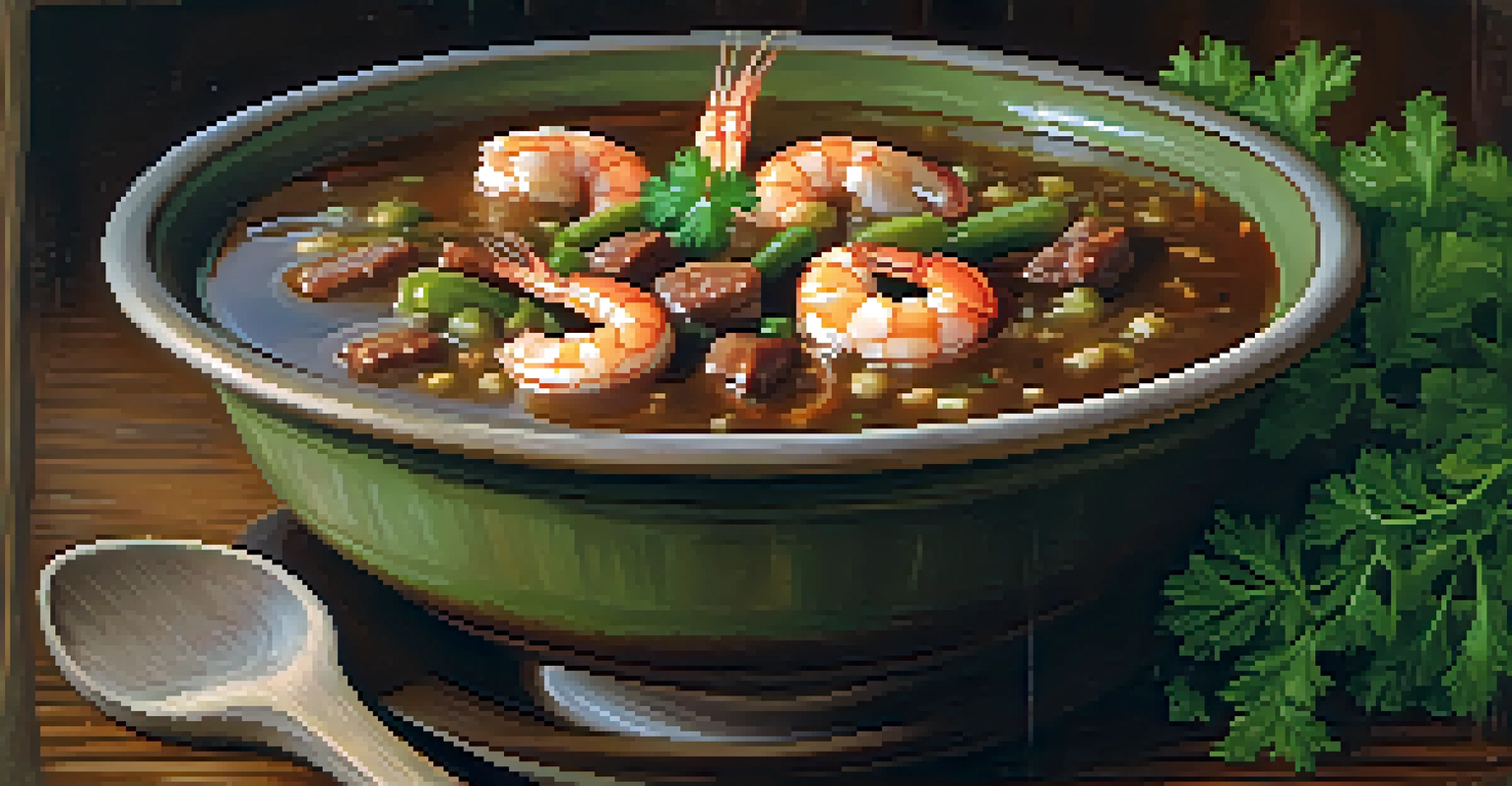The Impact of Cajun and Creole Cultures on American Society

Understanding Cajun and Creole: Distinct Yet Intertwined
Cajun and Creole cultures, while often confused, offer unique perspectives on American life. Cajuns are descendants of Acadian exiles from Canada, known for their strong ties to the land and vibrant traditions. In contrast, Creole culture is a blend of various influences, including French, Spanish, African, and Native American elements, resulting in rich diversity.
Food is our common ground, a universal experience.
These cultures emerged from the unique history of Louisiana, where settlers and indigenous peoples mingled. The result is a tapestry of customs, languages, and cuisines that reflect both resilience and creativity. Understanding their roots helps clarify their distinct contributions to American society.
Despite their differences, both Cajun and Creole cultures share a commitment to community and family, emphasizing hospitality and warmth. This shared ethos enriches the social fabric of America, making it a more inclusive and vibrant place.
Culinary Contributions: The Flavor of Louisiana
One of the most palpable impacts of Cajun and Creole cultures is their culinary legacy. Dishes like gumbo, jambalaya, and étouffée have become staples in American cuisine, celebrated for their bold flavors and unique ingredients. The use of spices, seafood, and local produce showcases the resourcefulness of these cultures.

Food not only satiates hunger but also tells a story—each recipe is steeped in history and culture. For instance, gumbo reflects the blending of various culinary traditions, showcasing how diverse influences can create something truly remarkable. This culinary fusion invites everyone to experience the rich heritage of Cajun and Creole cooking.
Cajun and Creole Cultures Explained
Cajun and Creole cultures, while distinct, share rich traditions that contribute uniquely to American life.
Moreover, the rise of food festivals, such as the New Orleans Jazz & Heritage Festival, highlights the importance of culinary arts in preserving cultural identity. These events not only celebrate food but also foster community, attracting visitors from all over and allowing them to experience these vibrant cultures firsthand.
Music: The Heartbeat of Cajun and Creole Cultures
Music is another powerful medium through which Cajun and Creole cultures have impacted American society. Genres like Zydeco and Cajun music are characterized by energetic rhythms and lively melodies, often featuring instruments like the accordion and fiddle. These musical styles have influenced a broader spectrum of American music, including rock and roll and country.
Music can change the world because it can change people.
The intermingling of cultural influences is evident in the themes and sounds of Cajun and Creole music, which often tell stories of love, loss, and resilience. This storytelling aspect connects with audiences, allowing them to appreciate the emotions behind the tunes. The lively atmosphere at local dance halls embodies the spirit of these communities.
Furthermore, festivals celebrating Cajun and Creole music draw large crowds, showcasing the importance of these genres in American culture. They serve as a reminder of how music can bridge cultural divides, creating a sense of belonging and appreciation for diverse backgrounds.
Language: The Preservation of Heritage
Language plays a vital role in preserving Cajun and Creole identities. Cajun French, a dialect rooted in the Acadian language, and Louisiana Creole, which blends French, Spanish, and African languages, reflect the historical journeys of these communities. While their use has declined, efforts are underway to keep these languages alive.
Schools and community programs are increasingly offering courses in Cajun and Creole languages, emphasizing their importance in cultural heritage. This revival not only helps preserve linguistic diversity but also strengthens community bonds, as language is a key component of identity. Learning these languages allows new generations to connect with their roots.
Culinary Legacy of Louisiana
Dishes such as gumbo and jambalaya showcase the vibrant culinary heritage of Cajun and Creole cultures.
Moreover, bilingual signage and literature in Louisiana celebrate the region's linguistic diversity, inviting locals and visitors alike to embrace its rich heritage. This linguistic landscape illustrates how language can shape cultural identity and foster a sense of pride among community members.
Festivals: Celebrating Cajun and Creole Heritage
Festivals such as Mardi Gras and the Cajun and Creole Food Festival are vibrant expressions of cultural heritage. These events bring communities together, showcasing art, music, and, of course, food. They allow people to celebrate their traditions while inviting others to join in the festivities.
The colorful parades, lively music, and delicious food create a festive atmosphere that captivates locals and tourists alike. Attendees get a taste of the unique Cajun and Creole traditions, fostering appreciation for these rich cultures. Festivals also serve as economic boosts for local communities, highlighting the importance of cultural celebrations.
These gatherings can be seen as a microcosm of American society, reflecting diversity and a shared love for community. Through celebrations, Cajun and Creole cultures continue to weave their narratives into the broader American story, ensuring their legacies endure for future generations.
Art and Literature: A Canvas of Cultural Expression
Cajun and Creole cultures have made significant contributions to the world of art and literature, capturing their unique experiences and perspectives. Artists and writers often draw inspiration from their surroundings, reflecting the beauty and struggles of their communities. This creative output helps to preserve and share their rich cultural narratives.
For instance, visual artists like George Rodrigue, known for his Blue Dog paintings, celebrate Louisiana's landscapes and folklore. Similarly, authors like Ernest Gaines illuminate the complexities of life in Louisiana through their storytelling. Their works resonate beyond the region, influencing American literature and art as a whole.
Music as Cultural Connection
Zydeco and Cajun music not only entertain but also serve as a vital expression of the communities' histories and emotions.
Moreover, the incorporation of local themes and motifs in art and literature fosters a greater understanding of Cajun and Creole cultures. This exchange of ideas enriches the broader cultural landscape, emphasizing the importance of representation and diversity in creative expression.
The Future of Cajun and Creole Cultures in America
As we move forward, Cajun and Creole cultures continue to evolve while preserving their unique identities. Younger generations are embracing their heritage, blending traditional practices with modern influences to create something new. This fusion ensures that these cultures remain dynamic and relevant in today's society.
Efforts to promote cultural education and awareness are crucial in maintaining the vibrancy of Cajun and Creole cultures. Schools and community organizations play a significant role in fostering appreciation for these traditions, ensuring they are passed down through generations. Engaging with the community helps keep these cultures alive and thriving.

Ultimately, the impact of Cajun and Creole cultures on American society is profound and enduring. By celebrating their rich history and adapting to contemporary life, these cultures will continue to enrich the American tapestry, inviting everyone to partake in their unique stories.